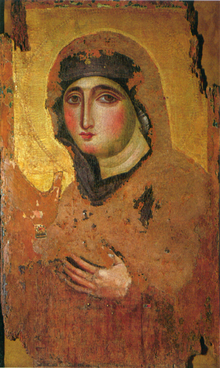
In art, a Madonna is a religious depiction of the Blessed Virgin Mary in a singular form or sometimes accompanied by the Child Jesus. These images are central icons for both the Roman Catholic and Orthodox churches. The word is from Italian ma donna 'my lady' (archaic). The Madonna and Child type is very prevalent in Christian iconography, divided into many traditional subtypes especially in Eastern Orthodox iconography, often known after the location of a notable icon of the type, such as the Theotokos of Vladimir, Agiosoritissa, Blachernitissa, etc., or descriptive of the depicted posture, as in Hodegetria, Eleusa, etc.
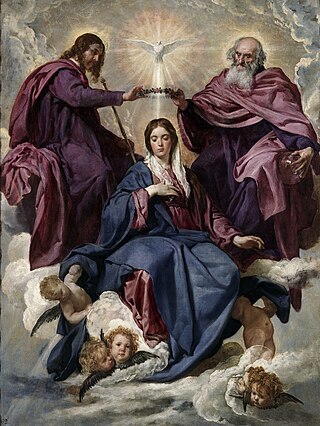
Queen of Heaven is a title given by the Catholic Church and Eastern Orthodoxy, to Mary, mother of Jesus, and, to a lesser extent, in Anglicanism and Lutheranism. The title has long been a tradition, included in prayers and devotional literature and seen in Western art in the subject of the Coronation of the Virgin from the High Middle Ages, long before the Church gave it a formal definition status.

The Caelian Hill is one of the famous seven hills of Rome.
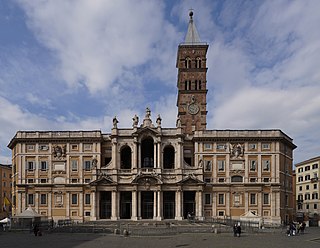
The Basilica of Saint Mary Major, or church of Santa Maria Maggiore, is one of the four major papal basilicas as well as one of the Seven Pilgrim Churches of Rome and the largest Marian church in Rome, Italy. Santa Maria Maggiore is the first Marian sanctuary in the Western world and the mother of all sanctuaries.

Madonna Della Strada or Santa Maria Della Strada is a painting of Mary, mother of Jesus at the Church of the Gesù in Rome, mother church of the Society of Jesus (Jesuits) religious order of the Catholic Church; it is a variation on the basilissa (imperial) type of icon.
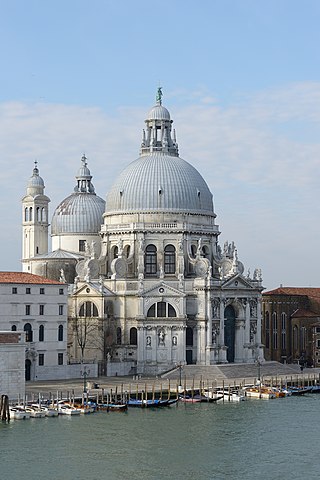
Santa Maria della Salute, commonly known simply as La Salute, is a Roman Catholic church and minor basilica located at the Punta della Dogana in the Dorsoduro sestiere of the city of Venice, Italy.

The Basilica of Santa Maria in Trastevere or Our Lady in Trastevere is a titular minor basilica in the Trastevere district of Rome, and one of the oldest churches of Rome. The basic floor plan and wall structure of the church date back to the 340s, and much of the structure to 1140–43. The first sanctuary was built in 221 and 227 by Pope Callixtus I and later completed by Pope Julius I. The church has large areas of important mosaics from the late 13th century by Pietro Cavallini.

Salus Populi Romani is a Roman Catholic title associated with the venerated image of the Blessed Virgin Mary in Rome. This Byzantine icon of the Madonna and Child Jesus holding a Gospel book on a gold ground, now heavily overpainted, is kept in the Borghese (Pauline) Chapel of the Basilica of Saint Mary Major.
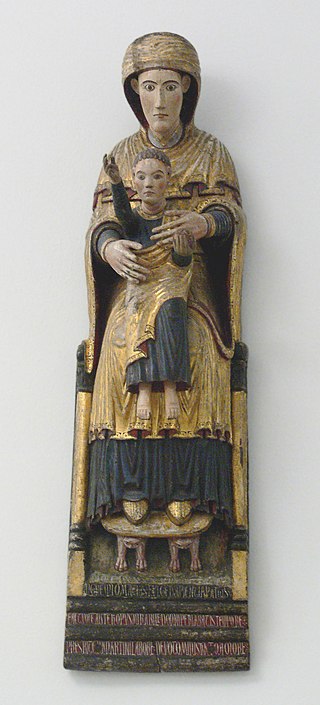
Seat of Wisdom or Throne of Wisdom is one of many devotional titles for Mary in Roman Catholic tradition. In Seat of Wisdom icons and sculptures, Mary is seated on a throne with the Christ Child on her lap. For the more domestic and intimate iconic representations of Mary with the infant Jesus on her lap, see Madonna and Child. The Roman Catholic Church honors Mary, Seat of Wisdom, with a feast day on June 8.

There are more than 930 churches in Rome, which makes it the city with the largest number of churches in the world. Almost all of these are Catholic.
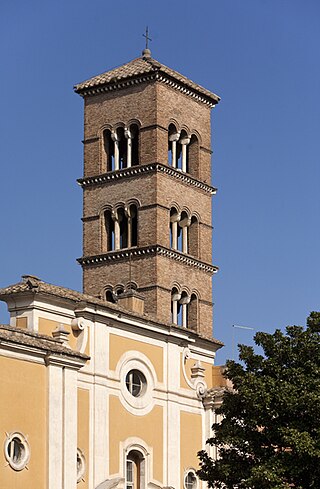
The Basilica of San Sisto Vecchio is a Catholic minor basilica and Dominican conventual church in Rome, Italy. It has been a titular church since 600 AD. Its Cardinal priest is currently Antoine Kambanda.

The Church of the Most Holy Name of Mary at the Trajan Forum is a Roman Catholic church in Rome, Italy. This church should not be confused with the church Santissimo Nome di Maria in Via Latina in south-east Rome.

A Hodegetria, or Virgin Hodegetria, is an iconographic depiction of the Theotokos holding the Child Jesus at her side while pointing to him as the source of salvation for humankind. The Virgin's head usually inclines towards the child, who raises his hand in a blessing gesture. Metals are often used to draw attention to young Christ, reflecting light and shining in a way to embody divinity. In the Western Church this type of icon is sometimes called Our Lady of the Way.

The Coronation of the Virgin or Coronation of Mary is a subject in Christian art, especially popular in Italy in the 13th to 15th centuries, but continuing in popularity until the 18th century and beyond. Christ, sometimes accompanied by God the Father and the Holy Spirit in the form of a dove, places a crown on the head of Mary as Queen of Heaven. In early versions the setting is a Heaven imagined as an earthly court, staffed by saints and angels; in later versions Heaven is more often seen as in the sky, with the figures seated on clouds. The subject is also notable as one where the whole Christian Trinity is often shown together, sometimes in unusual ways. Crowned Virgins are also seen in Eastern Orthodox Christian icons, specifically in the Russian Orthodox church after the 18th century. Mary is sometimes shown, in both Eastern and Western Christian art, being crowned by one or two angels, but this is considered a different subject.

Raimondo Spiazzi OP was an Italian Catholic theologian, advisor to Pius XII, and Mariologist with over 2,500 publications.
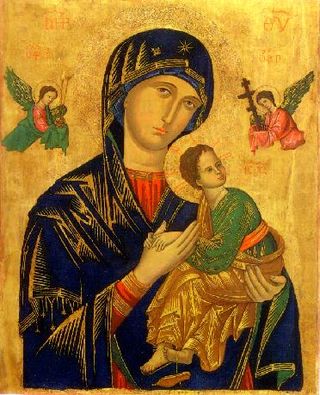
Mary has been one of the major subjects of Western art for centuries. There is an enormous quantity of Marian art in the Catholic Church, covering both devotional subjects such as the Virgin and Child and a range of narrative subjects from the Life of the Virgin, often arranged in cycles. Most medieval painters, and from the Reformation to about 1800 most from Catholic countries, have produced works, including old masters such as Michelangelo and Botticelli.

Saint Luke painting the Virgin is a devotional subject in art showing Luke the Evangelist painting the Virgin Mary with the Child Jesus. Such paintings were often created during the Renaissance for chapels of Saint Luke in European churches, and frequently recall the composition of the Salus Populi Romani, an icon based on the legend of Luke's portrait of Mary. Versions of the subject were sometimes painted as the masterpiece that many guilds required an artist to submit before receiving the title of master.

The Sancta Sanctorum is a Roman Catholic chapel entered via the Scala Sancta of the Lateran Palace in Rome. It was the original private chapel of the papacy before it moved to Avignon, and later to the Vatican Palace. The chapel is the only building from the old Lateran Palace that was not destroyed during its reconstruction.

The Panagia Agiosoritissa or Hagiosoritissa is the name for a type of Marian icon, showing Mary without child, slightly from the side with both hands raised in prayer. The type is known in Latin as Maria Advocata.

Evviva Maria is a usual thanksgiving cry used by Roman Catholics as an expression of popular devotion in honor of the Blessed Virgin Mary. It is a devotion promoted by a hymn composed by Capuchin friar Leonard of Port-Maurice at the beginning of the 18th century and associated with the devotion the Holy Name of Jesus and the Holy Name of Mary encouraged by various Popes since the time of Pius VI.
